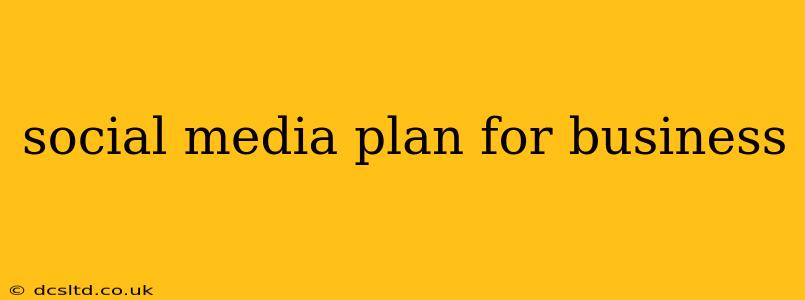Creating a successful social media plan isn't about throwing content online and hoping for the best. It requires a strategic approach, understanding your audience, and consistent effort. This guide will walk you through building a social media plan that drives engagement, builds your brand, and ultimately, boosts your business.
Understanding Your Audience: The Foundation of Success
Before diving into platforms and content, you need a clear picture of your target audience. Who are you trying to reach? What are their interests, demographics, and online behavior? Consider factors like age, location, income, and their preferred social media platforms. Understanding your audience allows you to tailor your messaging and choose the right platforms for maximum impact.
What are the demographics and psychographics of my target audience?
This is crucial. Demographics include age, gender, location, income, education, and occupation. Psychographics delve deeper into their values, lifestyle, interests, and attitudes. For example, a business selling sustainable clothing will target a different audience than one selling luxury handbags. Knowing these details allows you to craft messaging that resonates. Use analytics tools and market research to gather this information.
Choosing the Right Social Media Platforms
Not every platform is created equal. Your choice should align with your target audience's online habits. Consider the strengths of each platform:
- Facebook: Excellent for broad reach, building community, and running targeted advertising campaigns. Ideal for businesses of all sizes.
- Instagram: Visually driven, perfect for showcasing products, lifestyle, and behind-the-scenes content. Strong for brands focused on aesthetics and visual storytelling.
- Twitter: Real-time engagement, news sharing, and quick updates. Best for businesses needing to quickly respond to trends or customer queries.
- LinkedIn: Primarily professional networking. Ideal for B2B businesses, recruitment, and thought leadership.
- TikTok: Short-form video content, trending sounds, and viral potential. Great for reaching younger audiences and building brand awareness through creative content.
- Pinterest: Visual discovery platform, strong for businesses with visually appealing products or services. Excellent for driving traffic to your website.
What social media platforms are best for my business?
The "best" platforms depend entirely on your target audience and your business goals. If your audience is largely on Instagram and TikTok, focusing your efforts there makes more sense than spreading yourself thin across multiple platforms with minimal engagement.
Setting Your Social Media Goals
What do you hope to achieve with your social media efforts? Define specific, measurable, achievable, relevant, and time-bound (SMART) goals. Examples include:
- Increase brand awareness: Track website traffic, social media mentions, and follower growth.
- Drive website traffic: Use UTM parameters in your social media links to track which posts are sending traffic.
- Generate leads: Utilize lead generation forms or calls to action within your posts.
- Boost sales: Track sales directly attributed to social media campaigns.
How can I measure the success of my social media plan?
Regularly track key metrics such as engagement (likes, comments, shares), reach (number of unique users seeing your content), website clicks, and conversions (e.g., sales, sign-ups). Most social media platforms provide built-in analytics; leverage these to monitor your progress.
Content Strategy: Creating Engaging Content
Your content should be valuable, relevant, and consistent. Mix up your content formats to keep your audience engaged:
- Images: High-quality, visually appealing images are crucial.
- Videos: Short, engaging videos perform exceptionally well.
- Stories: Offer a behind-the-scenes glimpse into your business.
- Live streams: Interact directly with your audience in real-time.
- Blog posts: Share valuable information and drive traffic to your website.
- Infographics: Present complex information in an easily digestible format.
What kind of content should I post on social media?
Focus on content that provides value to your audience – entertain, educate, or inspire them. Consider what questions your audience has and address them through your content. Share user-generated content, run polls and quizzes, and offer exclusive discounts or promotions to encourage engagement.
Scheduling and Consistency: The Key to Success
Consistency is paramount. Create a content calendar to plan your posts in advance and maintain a regular posting schedule. Use scheduling tools to save time and ensure consistent posting across different platforms.
How often should I post on social media?
The optimal posting frequency varies depending on the platform and your audience. Research best practices for each platform and experiment to find what works best for you. Consistency is key—regular posting keeps your audience engaged.
Engaging with Your Audience: Building Relationships
Social media is a two-way street. Respond to comments, messages, and mentions promptly. Engage in conversations and build relationships with your followers. This fosters loyalty and strengthens your brand reputation.
Analyzing and Adapting: Continuous Improvement
Regularly review your social media analytics to identify what's working and what's not. Adapt your strategy based on the data to continually optimize your results. A successful social media plan is a living document that evolves with your business and your audience.
By following these steps and consistently adapting your strategy, you can create a powerful social media presence that drives results for your business. Remember, patience and persistence are key – building a strong social media presence takes time and dedication.
